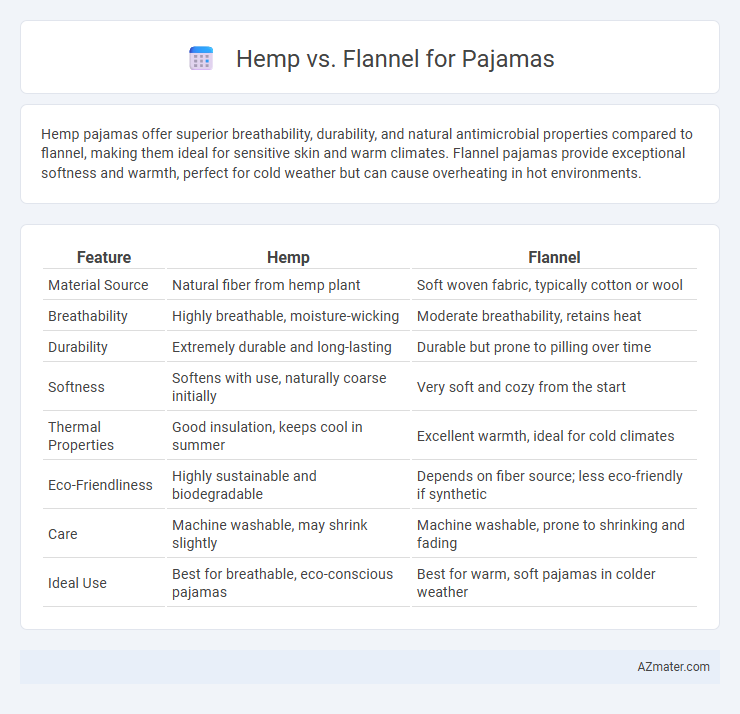Hemp pajamas offer superior breathability, durability, and natural antimicrobial properties compared to flannel, making them ideal for sensitive skin and warm climates. Flannel pajamas provide exceptional softness and warmth, perfect for cold weather but can cause overheating in hot environments.
Table of Comparison
| Feature | Hemp | Flannel |
|---|---|---|
| Material Source | Natural fiber from hemp plant | Soft woven fabric, typically cotton or wool |
| Breathability | Highly breathable, moisture-wicking | Moderate breathability, retains heat |
| Durability | Extremely durable and long-lasting | Durable but prone to pilling over time |
| Softness | Softens with use, naturally coarse initially | Very soft and cozy from the start |
| Thermal Properties | Good insulation, keeps cool in summer | Excellent warmth, ideal for cold climates |
| Eco-Friendliness | Highly sustainable and biodegradable | Depends on fiber source; less eco-friendly if synthetic |
| Care | Machine washable, may shrink slightly | Machine washable, prone to shrinking and fading |
| Ideal Use | Best for breathable, eco-conscious pajamas | Best for warm, soft pajamas in colder weather |
Introduction to Hemp and Flannel Pajamas
Hemp pajamas offer durability, breathability, and natural antimicrobial properties, making them ideal for sensitive skin and sustainable living. Flannel pajamas, crafted from soft, brushed cotton or wool, provide exceptional warmth and cozy comfort, perfect for colder climates or winter nights. Both fabrics address different needs, with hemp focusing on eco-friendly benefits and flannel excelling in thermal insulation.
Fabric Origins: Hemp vs Flannel Explained
Hemp fabric, derived from the stalks of the Cannabis sativa plant, is known for its durability, breathability, and eco-friendly cultivation process, thriving with minimal pesticides and water. Flannel, traditionally made from carded wool or cotton fibers, offers a soft, brushed texture that provides warmth and comfort, especially favored in colder climates. The natural toughness of hemp contrasts with flannel's cozy feel, making fabric origin a key factor in selecting pajamas for breathability versus insulation.
Comfort and Softness Comparison
Hemp pajamas offer breathability and durability with a slightly coarse texture that softens over time, making them ideal for eco-conscious sleepers seeking natural comfort. Flannel pajamas provide a plush, warm feel with a soft, fuzzy surface that excels in cold weather, delivering immediate coziness and a classic softness. Comparing comfort, hemp's moisture-wicking properties maintain dryness and temperature regulation, while flannel ensures insulation and a gentle touch against the skin.
Breathability and Temperature Regulation
Hemp pajamas offer superior breathability due to their natural moisture-wicking properties, keeping the skin dry and comfortable throughout the night. Flannel, while warm and cozy, tends to trap heat, making it less effective for temperature regulation in warmer climates. Choosing hemp fabric ensures better airflow and thermoregulation, ideal for maintaining an optimal sleep temperature year-round.
Durability and Longevity
Hemp pajamas offer superior durability due to their strong, long fibers that resist wear and tear, making them ideal for long-term use. Flannel pajamas provide warmth and softness but tend to wear out faster, especially with frequent washing, as the fibers can thin and pill over time. Choosing hemp ensures longer-lasting comfort and resilience, ideal for sustainable and durable sleepwear options.
Sustainability and Eco-Friendliness
Hemp pajamas offer superior sustainability due to hemp's rapid growth, minimal water usage, and natural pest resistance, reducing the need for harmful pesticides and fertilizers. Flannel, typically made from cotton or synthetic blends, often requires more intensive water and chemical inputs, impacting its overall eco-friendliness. Choosing hemp pajamas supports eco-conscious consumers seeking durable, biodegradable, and low-impact sleepwear options.
Skin Sensitivity and Hypoallergenic Qualities
Hemp pajamas offer superior breathability and natural antibacterial properties, making them ideal for sensitive skin and reducing allergic reactions. Flannel, while soft and warm, can sometimes cause irritation or itchiness for those with skin sensitivities due to its fiber texture and potential chemical treatments. Choosing hemp over flannel supports hypoallergenic comfort and promotes healthier skin for users prone to allergies or eczema.
Maintenance and Care Instructions
Hemp pajamas require minimal maintenance, benefiting from naturally antimicrobial and moisture-wicking properties that reduce washing frequency and prevent odors. Flannel pajamas need gentle care with cold water washing and air drying to maintain softness and prevent shrinking, as frequent laundering can degrade the fabric's nap. Both fabrics perform best when washed separately to avoid pilling and preserve longevity, but hemp's durability allows for more forgiving care routines compared to the delicate nature of flannel.
Price and Value Differences
Hemp pajamas typically cost more upfront than flannel due to the sustainable cultivation processes and durability of hemp fibers. Flannel pajamas, often made from cotton or wool blends, offer a lower price point and immediate warmth, making them a budget-friendly choice for colder seasons. While hemp pajamas provide long-term value through enhanced breathability and mildew resistance, flannel delivers quick softness and comfort at a more accessible price.
Which Pajama Fabric Should You Choose?
Hemp pajamas offer superior breathability and durability, making them ideal for those seeking eco-friendly, long-lasting sleepwear with natural moisture-wicking properties. Flannel pajamas excel in warmth and softness, providing cozy comfort during colder months due to their brushed cotton or wool fibers. Choose hemp for sustainable, breathable comfort year-round, while flannel is best for insulating warmth in cooler climates.

Infographic: Hemp vs Flannel for Pajama
 azmater.com
azmater.com